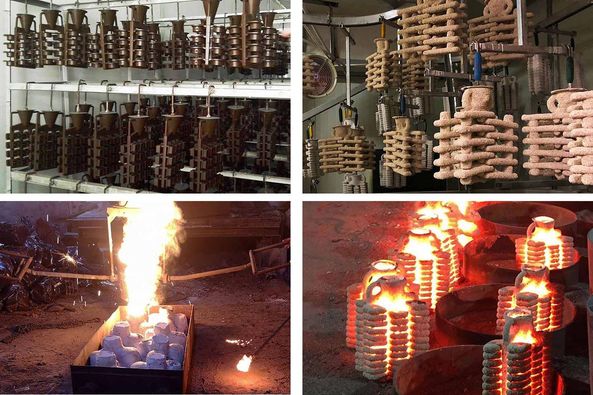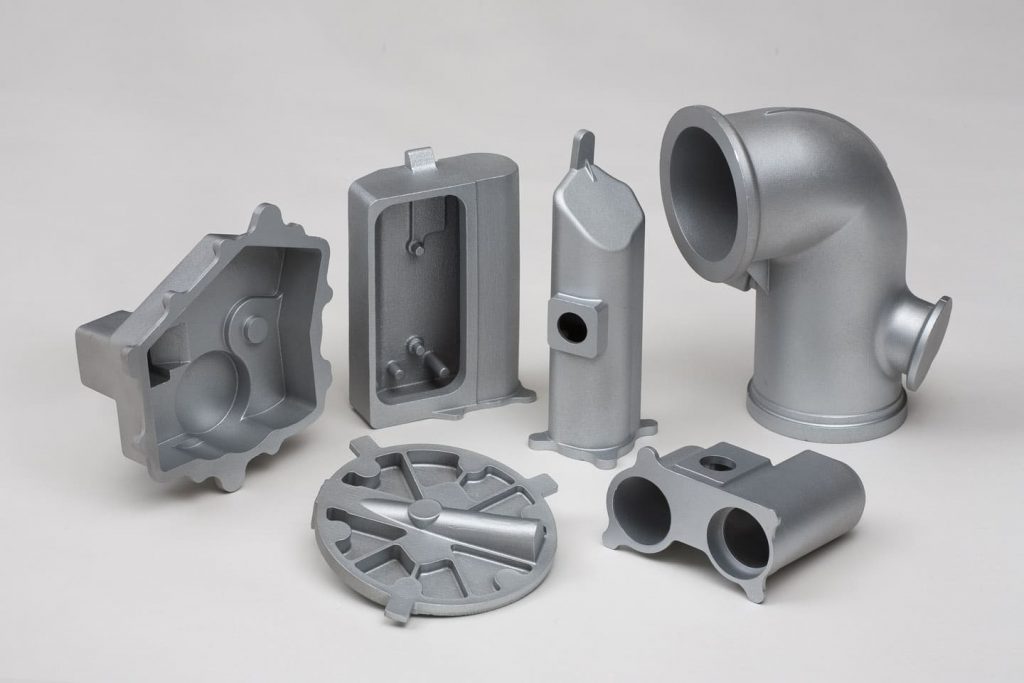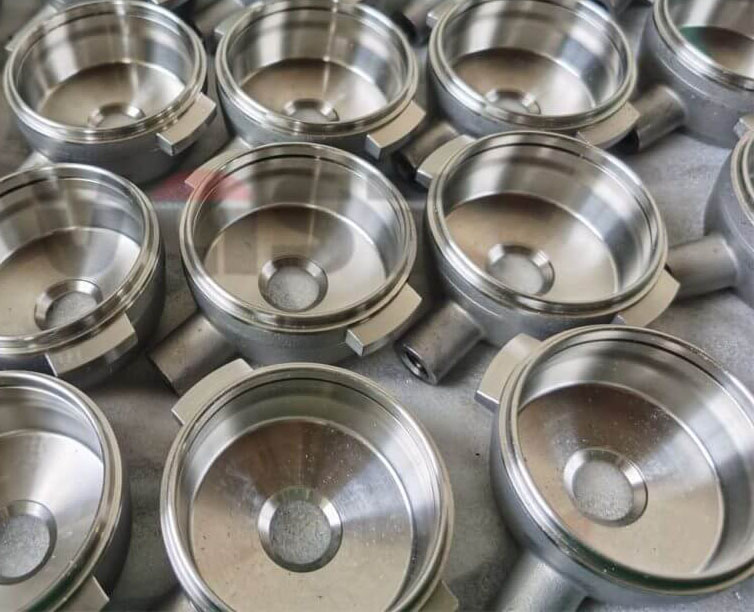Stainless steel casting is a process of producing intricate and complex parts and components from stainless steel. It is a popular manufacturing method due to its versatility, durability, and high resistance to corrosion and heat. Stainless steel casting is widely used in various industries such as automotive, aerospace, medical, and food processing.
Stainless steel casting offers a wide range of advantages over other manufacturing methods. It allows for the creation of complex shapes and designs that are difficult or impossible to produce with other methods. The process also ensures consistent quality and accuracy, resulting in parts and components that are highly precise and reliable. Additionally, stainless steel casting produces parts and components that are strong, durable, and resistant to wear and tear, making them ideal for use in harsh environments and applications.
Overview of Stainless Steel Casting Parts and Components
Stainless steel casting is a manufacturing process that involves the pouring of molten stainless steel into a mold to produce a wide range of parts and components. The investment casting process, also known as lost wax casting, is commonly used to produce high-quality stainless steel castings with intricate shapes and complex geometries.
The manufacturing process of stainless steel casting involves several steps, including wax pattern creation, ceramic shell coating, dewaxing, pouring, and finishing. The process is highly customizable, allowing for the production of parts and components with varying sizes, shapes, and specifications.
Stainless steel casting is widely used in various industries, including aerospace, automotive, medical, and marine. The high strength, corrosion resistance, and durability of stainless steel make it an ideal material for producing components that require high performance and reliability.
Some of the common stainless steel casting parts and components include valve bodies, pump components, impellers, gears, and turbine blades. These components are critical to the functioning of various machines and equipment, and their quality and performance are essential to the overall performance of the system.
In conclusion, stainless steel casting is a versatile and reliable manufacturing process that produces high-quality parts and components with intricate shapes and complex geometries. Its wide range of applications, customizability, and durability make it an ideal choice for various industries.
Advantages of Stainless Steel Casting Parts and Components
Stainless steel casting is a popular method of manufacturing components and parts in various industries. It offers several advantages over other manufacturing methods such as forging, machining, and stamping. Here are some of the key advantages of stainless steel casting parts and components:
Corrosion Resistance
Stainless steel is known for its excellent resistance to corrosion. It contains chromium, which reacts with oxygen in the air to form a thin, invisible layer of chromium oxide on the surface of the steel. This layer prevents further corrosion and protects the underlying steel from damage. Stainless steel casting parts and components are therefore ideal for use in harsh environments where corrosion is a concern.
Durability
Stainless steel is a highly durable material that can withstand the rigors of heavy use and extreme conditions. It is resistant to wear, abrasion, and impact, making it ideal for use in applications that require high strength and toughness. Stainless steel casting parts and components are also highly resistant to fatigue, which means they can withstand repeated stress and strain without failure.
Strength
Stainless steel is a strong material that can support heavy loads and withstand high pressures. It has a high tensile strength, which means it can resist stretching and pulling forces without breaking. Stainless steel casting parts and components are therefore ideal for use in applications that require high strength and durability.
Heat Resistance
Stainless steel is highly resistant to heat and can withstand high temperatures without melting or deforming. It has a high melting point and can resist thermal shock, making it ideal for use in high-temperature applications such as furnace components, heat exchangers, and exhaust systems.
Efficiency
Stainless steel casting is a highly efficient manufacturing method that can produce complex shapes and intricate details with high precision and accuracy. It can also produce parts and components with a high degree of repeatability, which means that each part is identical to the next. This makes stainless steel casting ideal for use in mass-production applications where consistency and quality are important.
In summary, stainless steel casting parts and components offer several advantages over other manufacturing methods. They are highly corrosion-resistant, durable, strong, heat-resistant, and efficient. These properties make them ideal for use in a wide range of applications across various industries.

Types of Stainless Steel Casting Alloys
Stainless steel casting is a popular manufacturing process for producing high-quality parts and components. There are several types of stainless steel casting alloys available, each with unique properties and characteristics. In this section, we will discuss some of the most common types of stainless steel casting alloys.
Austenitic Stainless Steel
Austenitic stainless steel is a popular choice for stainless steel casting due to its excellent corrosion resistance, high ductility, and low magnetic permeability. It contains high levels of chromium and nickel, which provide its excellent corrosion resistance. This type of stainless steel is also known for its high-temperature strength and good weldability.
Duplex Stainless Steel
Duplex stainless steel is a two-phase microstructure consisting of both austenitic and ferritic phases. This type of stainless steel casting alloy offers a combination of high strength and excellent corrosion resistance. It is often used in applications where high strength and resistance to stress corrosion cracking are required.
Ferritic Stainless Steel
Ferritic stainless steel is a low-cost alternative to austenitic stainless steel. It contains high levels of chromium but low levels of nickel, which makes it less expensive to produce. This type of stainless steel is known for its good corrosion resistance and high-temperature strength.
Martensitic Stainless Steel
Martensitic stainless steel is a type of stainless steel that can be hardened and tempered. It contains high levels of carbon and low levels of nickel, which makes it less expensive than austenitic stainless steel. This type of stainless steel is often used in applications where high hardness and wear resistance are required.
Other Elements
In addition to the above alloys, other elements can be added to stainless steel casting alloys to enhance their properties. For example, the addition of phosphorus can improve the machinability of stainless steel, while the addition of nitrogen can improve its strength. Chromium, molybdenum, nickel, aluminum, titanium, and copper are also commonly added to stainless steel casting alloys to enhance their properties.
Overall, stainless steel casting alloys offer a wide range of properties and characteristics that make them suitable for various applications. By understanding the different types of stainless steel casting alloys available, manufacturers can choose the best alloy for their specific application.
Stainless Steel Casting Process
Stainless steel casting is a process used to create complex parts and components from molten stainless steel. The process involves several steps, including wax pattern creation, lost wax casting, and precision casting.
The first step in stainless steel casting is creating a wax pattern of the desired part or component. This is done by injecting wax into a mold that has been created from the specifications of the part. The wax pattern is then removed from the mold and prepared for the next step.
The next step in the process is lost wax casting. The wax pattern is coated with a ceramic material, which creates a mold when heated. The mold is then heated to remove the wax pattern, leaving behind a cavity in the shape of the desired part.
The mold is then filled with molten stainless steel using precision casting techniques. This ensures that the steel fills the cavity completely and creates a part that is accurate and consistent in size and shape.
Other casting processes, such as sand casting and plaster casting, can also be used to create stainless steel parts. However, these processes are generally less precise and produce parts that may not be as consistent in size and shape.
Overall, the stainless steel casting process is a reliable and precise method for creating complex parts and components from molten stainless steel.

Applications of Stainless Steel Casting Parts and Components
Stainless steel casting has a wide range of applications in various industries due to its exceptional properties such as corrosion resistance, durability, and strength. The following paragraphs will discuss some of the common applications of stainless steel casting parts and components.
Marine
Stainless steel casting is extensively used in the marine industry due to its resistance to corrosion caused by saltwater and other harsh environmental conditions. It is used in the manufacturing of various components such as propellers, pumps, valves, and fittings.
Automotive
Stainless steel casting is used in the automotive industry for manufacturing various components such as engine parts, exhaust systems, and suspension parts. The superior strength and durability of stainless steel make it an ideal material for these applications.
Aerospace
Stainless steel casting is used in the aerospace industry for manufacturing various components such as turbine blades, exhaust systems, and structural components. The excellent strength-to-weight ratio of stainless steel makes it an ideal material for these applications.
Military
Stainless steel casting is used in military applications due to its exceptional strength and durability. It is used in the manufacturing of various components such as armor plates, missile components, and aircraft parts.
Food Processing Equipment
Stainless steel casting is extensively used in the food processing industry due to its resistance to corrosion caused by acidic and alkaline substances. It is used in the manufacturing of various components such as meat mincers, mixing tanks, pumps, and valves.
Petrochemical
Stainless steel casting is used in the petrochemical industry for manufacturing various components such as heat exchangers, valves, and fittings. The resistance of stainless steel to high temperatures and corrosive substances makes it an ideal material for these applications.
Pharmaceutical
Stainless steel casting is used in the pharmaceutical industry for manufacturing various components such as containers, mixing tanks, and pumps. The corrosion resistance and ease of cleaning of stainless steel make it an ideal material for these applications.
Industrial Applications
Stainless steel casting is used in various industrial applications such as manufacturing machinery, pumps, and valves. The excellent strength and durability of stainless steel make it an ideal material for these applications.
Kitchenware
Stainless steel casting is used in the manufacturing of various kitchenware such as pots, pans, and utensils. The corrosion resistance and ease of cleaning of stainless steel make it an ideal material for these applications.
Other Applications
Stainless steel casting is also used in the manufacturing of various components such as bolts, flanges, gears, handles, housings, and assemblies. The exceptional properties of stainless steel make it an ideal material for these applications.
Stainless Steel Grades and Properties
Stainless steel is an alloy of iron, carbon, and other elements that contain at least 10.5% chromium. The addition of chromium gives stainless steel its unique properties, including corrosion resistance, hardness, and strength. There are many grades of stainless steel available, each with its own unique properties and characteristics.
ASTM International is a leading organization that sets standards for materials, products, systems, and services. They have established standards for stainless steel grades, which are widely used in the industry. Some of the most common stainless steel grades include:
- 304: This is the most commonly used stainless steel grade. It has excellent corrosion resistance, high strength, and good ductility. It contains 18% chromium and 8% nickel, and has a carbon content of 0.08%.
- 316: This is a higher grade of stainless steel that contains 16% chromium, 10% nickel, and 2% molybdenum. It has excellent corrosion resistance and is often used in marine environments.
- 410: This is a martensitic stainless steel grade that contains 11.5% chromium. It is often used for applications that require high strength and hardness.
The chemical composition of stainless steel can vary depending on the grade. However, most stainless steel grades contain chromium and nickel, which are the key elements that give stainless steel its unique properties. The carbon content, chromium content, and heat treatment can also affect the properties of stainless steel.
Stainless steel is known for its excellent corrosion resistance, which is due to the presence of chromium. Chromium forms a passive layer on the surface of the steel, which prevents corrosion from occurring. Stainless steel is also known for its high strength, hardness, and ductility. It has a high tensile strength and yield strength, which makes it ideal for applications that require high strength.
Stainless steel is often used in applications that require tight tolerances and precision casting. It is also known for its integrity and efficient production. Stainless steel is heat-resistant and can withstand high temperatures, making it ideal for high-temperature applications.
In summary, stainless steel is an alloy that contains at least 10.5% chromium. There are many grades of stainless steel available, each with its own unique properties and characteristics. The chemical composition, corrosion resistance, hardness, tensile strength, yield strength, ductility, carbon content, chromium content, heat treatment, heat resistance, high strength, tight tolerance, precision casting, integrity, and efficient production are all important factors to consider when selecting a stainless steel grade for a specific application.
Comparison of Stainless Steel Casting Parts and Components with Other Materials
Stainless steel casting parts and components have gained immense popularity in the manufacturing industry due to their exceptional properties. When compared to other materials such as forging, welding, and metal alloys, stainless steel casting parts stand out in terms of durability, strength, and resistance to corrosion.
Durability
Stainless steel casting parts and components possess excellent durability and can withstand extreme temperatures and harsh environments without losing their physical properties. In comparison, forging and welding may cause the material to lose its strength and durability due to the high temperature involved in the process.
Strength
Stainless steel casting parts and components have exceptional strength and can withstand high pressure and stress. In comparison, metal alloys may have a higher strength than stainless steel casting parts, but they can be brittle and prone to cracking under pressure.
Resistance to Corrosion
Stainless steel casting parts and components are highly resistant to corrosion, making them ideal for use in harsh environments. In comparison, metal alloys may corrode over time, leading to a reduction in their lifespan.
Cost
The cost of stainless steel casting parts and components may be higher than that of forging or welding, but it is often more cost-effective in the long run due to its durability and resistance to corrosion.
Overall, stainless steel casting parts and components offer exceptional properties that make them a preferred choice in various industries, including aerospace, automotive, and medical. The comparison with other materials such as forging, welding, and metal alloys highlights the advantages of using stainless steel casting parts and components in manufacturing.

Cost and Quote for Stainless Steel Casting Parts and Components
When it comes to stainless steel casting parts and components, cost is a critical factor for most buyers. The cost of producing these parts can vary depending on several factors such as material costs, production volume, and the complexity of the part.
To get an accurate quote for stainless steel casting parts and components, buyers should provide detailed information about the part they need. This includes the part’s specifications, quantity, and any additional requirements such as surface finish or heat treatment. With this information, the manufacturer can determine the cost of production and provide a quote.
Production volume can also affect the cost of stainless steel casting parts and components. High volume production can result in more economical undercutting, which can reduce the cost per part. However, it is important to note that the cost of tooling and setup can be higher for low volume production runs.
When requesting a quote for stainless steel casting parts and components, it is essential to work with a reputable manufacturer who can provide accurate pricing and high-quality parts. Buyers should consider factors such as the manufacturer’s experience, capabilities, and quality control processes when selecting a supplier.
In summary, cost is an essential factor to consider when purchasing stainless steel casting parts and components. Buyers should provide detailed information about the part they need to receive an accurate quote. The production volume can also affect the cost per part, and it is crucial to work with a reputable manufacturer to ensure high-quality parts at a fair price.
